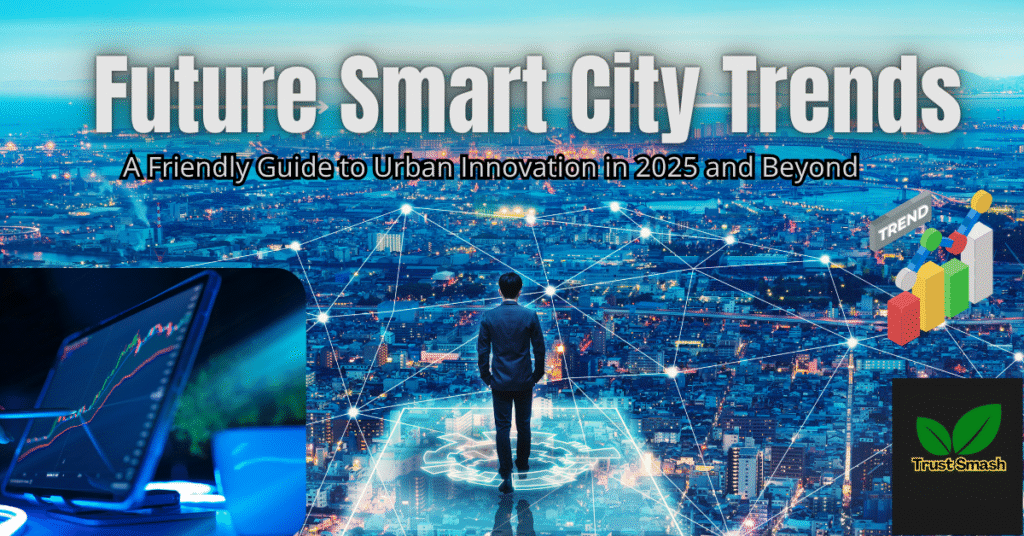Table of Contents
Introduction: About Future Smart City Trends

The idea of future smart city trends is becoming a reality because urban areas and global cities are developing rapidly across the United States. But are smart cities the future of urban life? With increasing challenges in stability, traffic management, and digital regime, the answer is a clear yes. From current smart cities such as Austin and Chicago to 2050 planned future smart cities, technology and innovation are bringing deep changes. This guide explains what is coming next and why these trends matter equally to urban planners, government policy makers, and investors.
How Smart Cities are Shaping Urban Life Today
Many current smart cities integrate IOT, AI, and digital infrastructure to improve the quality of life. For example, cities such as Austin and Portland use smart sensors to customize traffic flows and reduce pollution. It is part of a large innings towards digital infrastructure that supports real-time data sharing and future state analysis.
In addition, urban mobility solutions such as electric scooters and microgrids for power management explain how technology can reduce carbon footprints while increasing efficiency. This progress also supports environmental stability advisors and municipal decision makers in planning smart, green cities.
Key Future Smart City Trends to Watch in 2025
Further, the trend of future smart cities focuses too much on integrating AI and machine learning for 2025 urban management. This includes smart traffic control systems that reduce congestion and improve public transit reliability. Cities are also experimenting with blockchain for safe data management and promoting reality to assist in urban planning.
In addition, there is a push to the associated urban systems that originally add transportation, energy, and emergency services. These systems rely on strong IoTs in the structure of smart cities that allow quick communication between equipment, reducing the response time and increasing public safety.
The Role of Sustainability in Future Urban Development
Stability is among the main factors influencing smart cities’ future directions. Many cities have ambitious goals to be carbon-neutral by 2050 as awareness of climate change grows.
This includes widely using green technology in solar-powered streetlights, electric vehicle infrastructure, and intelligent trash disposal systems.
Smart cities are also emphasizing the idea of “15-minute cities,” whereby residents would cover a short walking or bicycling distance to jobs, shopping, and leisure. It lowers vehicle reliance and fosters neighborhoods more connected and healthy
How Technology is Revolutionizing City Governance
Future trends of smart cities include innovation in governance. Using urban data analytics, city officials may take data-driven decisions to allocate resources more efficiently.
This transparency enhances civil confidence and engagement, which is important for long-term success.
In addition, the AI-operated chatbots and digital identity systems simplify access to public services, creating a more inclusive urban environment. These technologies enable government policy makers and public-private participation to give better service to their communities.
Examples of Future Smart City Projects in the USA
Many American cities are moving forward with ambitious smart city initiatives. For example, Austin’s smart traffic system uses AI to adjust traffic lights based on real-time conditions, which reduces the waiting time.
Meanwhile, Chicago is investing heavily in urban innovation, combining IOT sensors with stability projects.
Even small cities like Augusta and Battle Creek are participating, showing that future smart city trends are not limited to large urban centers. These examples throw light on how technology and plans to create habitable, flexible communities across the country come together.
Challenges and Opportunities Ahead
While the trends of the future smart city are promising, they come with challenges. Data privacy concerns, funding intervals, and technical terms require careful management.
Cooperation between tech startup founders, urban planners, and environmental stability advisors is necessary to remove these obstacles. At the same time, these challenges provide innovation and investment opportunities.
Smart City Market is growing rapidly, attracting interest from investors in urban innovation, eager to support scalable solutions.
Conclusion: Embracing the Future of Smart Cities
The future of urban life is bright with the trends of the future smart city, leading to durable, connected, and skilled communities. For stakeholders from government officials to tech innovators, it is important to remain informed and active.
As we get close to 2050, the vision of the future city that balances technology, environment, and human needs is becoming clear.
Is Are smart city the future? without a doubt. And today, by embracing these trends, we can build cities that are clever, greenery, and better places to stay for generations to come.
Call to Action:
Stay ahead in urban innovation—subscribe to our newsletter for the latest updates on smart city trends and technology shaping the future of cities.
FAQS [FREQUENTLY ASKED QUESTIONS]
-
What is the future of smart cities?
Efficient, environmentally friendly urban settings will be created by AI, IoT, and sustainable technology in smart cities. Their goals are to improve living standards and lower carbon footprints.
-
What are the latest smart city trends?
Latest developments include artificial intelligence-based traffic control, 5G connectivity, green infrastructure, digital twins, and data-driven governance for smarter decision-making.
-
What are the main trends of a smart and sustainable city?
Key trends are smart mobility, IoT-enabled infrastructure, real-time data monitoring for effective resource management, and renewable energy use.
-
What will be the future of cities?
Emerging technologies will enable future cities to be strongly connected, AI-driven, created for sustainability, resiliency, and citizen-centric services.